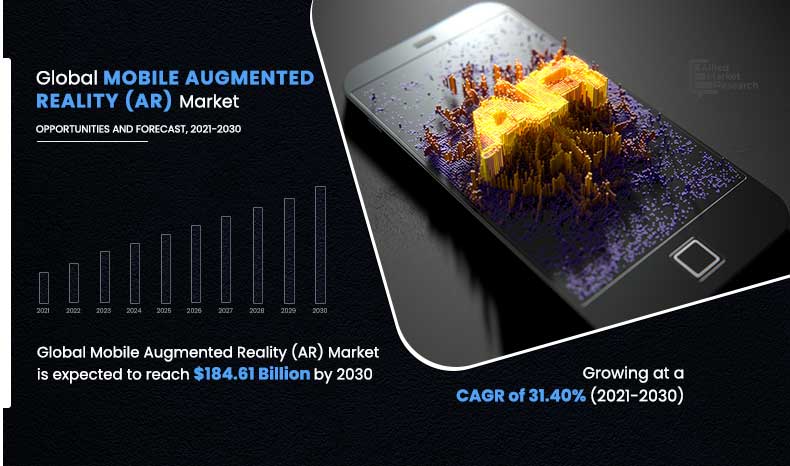Mobile Augmented Reality (AR) Market Research, 2030
The global mobile augmented reality (AR) market size is expected to reach $184.61 billion by 2030 from $12.61 billion in 2020, growing at a CAGR of 31.40% from 2021 to 2030.
Mobile augmented reality is one of the most explosive growth areas for AR applications currently. Mobile AR takes advantage of the widely distributed base of hardware, such as smartphones and tablets. Mobile devices that can support AR are becoming more powerful and less expensive at a very rapid pace. Additionally, new hardware possibilities are emerging, such as mobile projection devices that will allow new types of mobile AR applications.
In addition, mobile AR enables a certain type of health intervention that can be deployed anywhere the patient is located and at various times. Mobile technologies are an increasingly promising platform for health interventions because they are attractive and familiar to patients and because of their ubiquity. Also, AR technology is more cost-efficient than virtual reality and other comparable mobile emerging technologies because many patients already have these devices. All of these factors can increase the adoption of AR applications and the self-efficacy of patients to engage with these interventions.
Moreover, with the continuous and rapid advancements in the technology sector, AR applications have emerged as a medium that allows companies to interact with consumers innovatively and easily. AR has been defined as a visualization technique that superimposes computer-generated data, such as text, video, graphics, GPS data, and other multimedia formats on top of the real-world view, as captured from the camera of a computer, mobile phone, or other devices. Augmented reality is the reality of the future educational system. Technology is already a significant factor impacting the education sector with digital content, smart classrooms, and online assessments. Schools and colleges are changing their traditional methods of teaching with the use of AR applications.
The global mobile augmented reality (AR) market size is anticipated to witness significant growth during the forecast period. Factors such as high usage of Mobile AR in the healthcare industry, rapid growth of the retail industry, and surge in adoption of AR technology by the tourism and education sectors drive the mobile augmented reality (AR) market growth. Using AR applications in the tourism sector will become inevitable for companies to remain competitive in this business. In the tourism sector, AR application possesses great capabilities by improving the tourist experience and providing important information to tourists. Also, implementing new technologies such as AR will empower students and teachers to explore and learn more effectively. Nowadays, several companies worldwide are using augmented reality to provide a better learning and training experience in the education sector.
However, a limited user interface affecting navigation performance of AR apps is a major restraint on the global market growth. In addition, the rising adoption of AR smart glasses is expected to create opportunities for the mobile augmented reality (AR) industry.
Segmentation Overview:
The global mobile augmented reality (AR) market share is segmented based on component, device type, application, and region.
By component, it is divided into hardware, software, and services. The hardware segment is further sub-segmented into 3d camera, sensors, processor, and others. By device type, it is fragmented into smartphones, tablets, personal digital assistants (PDAs), and others
By Component
Services segment is projected as one of the most lucrative segments.
Depending on the application, it is separated into consumer, healthcare, enterprise, commercial, aerospace & defense, and others.
By Application
Consumer segment is expected to secure leading position during forecast period.
Region-wise, the mobile augmented reality (AR) market trends are analyzed across North America (U.S., Canada, and Mexico), Europe (UK, Germany, France, Italy, and Rest of Europe), Asia-Pacific (China, Japan, India, South Korea, Taiwan, and Rest of Asia-Pacific), and LAMEA (Latin America, the Middle East, and Africa). Asia-Pacific is expected to grow at the highest CAGR during the forecast period, due to an increasing adoption of mobile AR for different applications such as healthcare, education, tourism, and e-commerce sectors.
By Region
Asia-Pacific region would exhibit the highest CAGR of 32.80% during 2021-2030
Top Impacting Factors
The prominent factors that impact the mobile augmented reality (AR) market growth are high usage of Mobile AR in the healthcare industry, rapid growth of the retail industry, and a surge in the adoption of AR technology by the tourism and education sectors. However, a Limited user interface affecting navigation performance of AR apps restricts the market growth. On the contrary, the rising adoption of AR smart glasses is expected to create lucrative opportunities for the market. Therefore, these factors are expected to affect the global mobile augmented reality (AR) industry during the forecast period.
Competition Analysis
Competitive analysis and profiles of the major mobile augmented reality (AR) market players, such as Qualcomm Inc., Microsoft Corporation, Samsung Electronics Co. Ltd., Blippar.Com Ltd., Google, Apple, Magic Leap, Groove Jones, Wikitude, and Marxent Labs, are focusing their investment on technologically advanced, cost-effective, and more secure products and solutions for various applications.
A sudden decline in infrastructure development is expected to hamper the market growth for the consumer, education, and tourism sectors.
The slowdown in production by OEMs and a reduction in demand for mobile devices and other electronic devices has slightly pulled down the market for mobile AR. Shortages of components and materials have significantly impacted the global supply chains. In addition, reductions in various budgets and delays in planned projects in various industries have hampered the global economy.
However, post-COVID-19, the AR technology is gaining slight traction owing to its benefits in visualization, annotation, and storytelling. AR technologies are aiding online learning and also offering access to cultural events, which is helping users to overcome the isolation of lockdowns. Several countries, such as China, Japan, South Korea, and India, are also expecting quick control over the outbreak, following a pre-emptive response in the form of lockdowns and social distancing.
Moreover, as vaccines roll out across the globe and the pandemic situation is better controlled, especially in North America and Europe. This would boost the recovery of the mobile augmented reality (AR) market.
Key Benefits For Stakeholders
- This study comprises an analytical depiction of the global mobile augmented reality (AR) market outlook, along with the current trends and future estimations to depict the imminent investment pockets.
- The overall mobile augmented reality (AR) market analysis is determined to understand the profitable trends to gain a stronger foothold.
- The report presents information related to key drivers, restraints, and mobile augmented reality (AR) market opportunities with a detailed impact analysis.
- The current mobile augmented reality (AR) market forecast is quantitatively analyzed from 2020 to 2030 to benchmark the financial competency.
- Porter’s five forces analysis illustrates the potency of the buyers and the mobile augmented reality (AR) market share of key vendors.
- The report includes the market trends and the revenue share of key vendors.
Mobile Augmented Reality (AR) Market Report Highlights
| Aspects | Details |
| By Component |
|
| By Device Type |
|
| By Application |
|
| By Region |
|
| Key Market Players | Groove Jones, LLC, Marxent Labs, LLC, Microsoft Corporation, Magic Leap, Inc., Wikitude GmbH, Samsung Electronics Co. Ltd. (Samsung), Qualcomm Technologies, Inc., Google LLC (Alphabet Inc.), Blippar, Apple Inc. |
Analyst Review
According to the insights of the CXOs of leading companies, the mobile augmented reality (AR) market holds high potential in the retail, and tourism, e-commerce industry. Factors, such as high usage of Mobile AR in healthcare industry, rapid growth of the retail industry, and surge in adoption of AR technology by tourism and education sector drive the mobile augmented reality (AR) market growth. Several companies in this industry adopt various innovative techniques to provide customers with advanced and innovative features. However, limited user interface affecting navigation performance of AR apps is a major restraint to the global market growth. In addition, rising adoption of AR smart glasses is expected to create opportunities for the mobile augmented reality (AR) industry
Asia-Pacific is expected to at a highest CAGR during the forecast period, due to an increasing adoption of mobile AR for different applications such as healthcare, education, tourism, and e-commerce sectors. Also, high adoption of advance technologies in retail industry offer growth opportunities for mobile augmented reality (AR) market. In addition, North America was the largest contributor, in terms of revenue, and is expected to witness a significant growth during the forecast period.
The key players of the market focus on introducing technologically advanced products to remain competitive in the market. Product launch, agreement, collaboration, and partnership are expected to be the prominent strategies adopted by the market players.
Loading Table Of Content...




